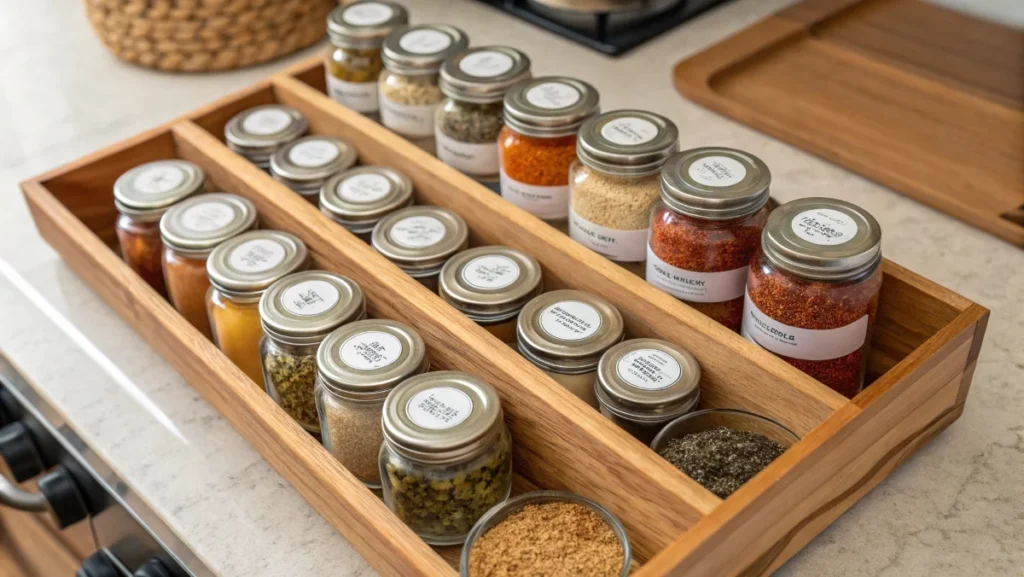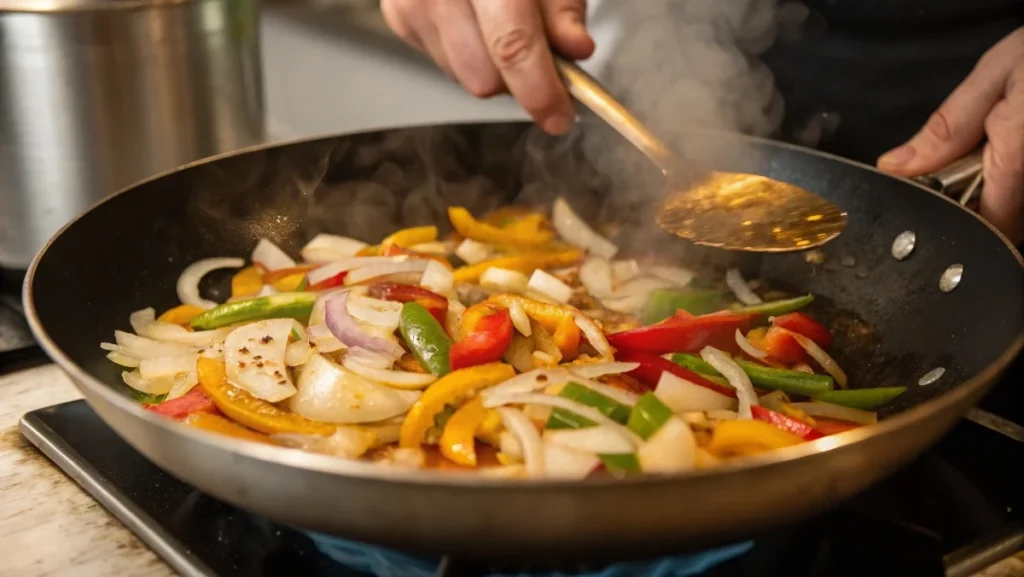If you’re wondering how to add flavor to beans, you’re not alone! Whether you’re cooking dried beans or using canned beans, the right seasonings, aromatics, and cooking techniques make all the difference. In this guide, you’ll discover 7 best ways to add flavor to beans, so every dish turns out delicious.. Whether you’re making black beans, pinto beans, chickpeas, or lentils, the key to delicious, restaurant-quality beans lies in using the right spices, herbs, fats, and cooking methods.
Table of Contents
Why Do Beans Taste Bland?
How to add flavor to beans is a common challenge, as beans are a fantastic source of protein and fiber but often taste bland or earthy on their own. Before exploring ways to add flavor to beans, let’s understand why they sometimes lack taste and how restaurants make them rich and flavorful.
Understanding the Natural Flavor of Beans
Not all beans taste the same, but most have a mild, starchy flavor that absorbs seasonings well. If you’re wondering how to add flavor to beans, it’s important to consider the bean variety, cooking method, and seasonings used.
The natural taste of beans depends on:
✔ The variety – Black beans have a deeper, richer flavor, while navy beans and chickpeas taste milder.
✔ How they’re cooked – Slow-cooked beans absorb more seasonings, making them taste better.
✔ What they’re cooked with – Beans need salt, spices, and aromatics to develop a delicious taste.
By using the best seasonings for beans and the right cooking techniques, you can turn bland beans into flavorful, restaurant-quality dishes.
The Science Behind Flavor Absorption
Beans are like little sponges—they absorb flavors best when cooked slowly. Their outer skin and dense texture make it harder for seasonings to penetrate quickly. That’s why timing matters when adding salt, spices, and aromatics.
Here’s a simple breakdown of when to add seasonings for maximum flavor:
| Seasoning Type | When to Add It |
|---|---|
| Salt | Near the end of cooking |
| Spices & Herbs | At the start (for depth) + end (for freshness) |
| Aromatics (onions, garlic) | Sauté first, then add beans |
| Acid (lemon, vinegar) | At the very end for brightness |
Why Some Beans Taste Better at Restaurants
Ever wonder why restaurant beans taste so much better than homemade ones?
🔹 Slow Cooking – Many restaurants simmer beans for hours, allowing flavors to develop.
🔹 Broth Instead of Water – Cooking beans in broth adds instant richness.
🔹 Umami Boosters – Ingredients like smoked paprika, miso, and tomato paste make beans taste deeper and more savory.
🔹 Seasoning in Layers – Restaurants add spices early, salt late, and acid at the end to build flavor.
PART 2: How to Add Flavor to Beans with the Right Seasonings

Looking for the best seasonings for beans? The right combination of spices, aromatics, and fats will completely transform the way you add flavor to beans. If you’ve ever wondered how to make beans taste better, we’ve got you covered! Whether you’re making black beans, pinto beans, chickpeas, or lentils, choosing the right spices, herbs, and umami boosters is key.
How to Add Flavor to Beans with the Best Spices
Beans pair well with warm, smoky, and earthy spices. Here are some of the best seasonings to use:
| Spice/Herb | Best Bean Pairings | Flavor Profile |
|---|---|---|
| Cumin | Black beans, pinto beans | Earthy, warm |
| Smoked Paprika | Kidney beans, chickpeas | Smoky, slightly sweet |
| Oregano | Navy beans, cannellini beans | Herbal, slightly bitter |
| Thyme | Great Northern beans, lentils | Earthy, aromatic |
| Bay Leaves | All bean varieties | Mild, floral |
| Chili Powder | Pinto beans, black beans | Spicy, smoky |
| Coriander | Chickpeas, lentils | Citrusy, warm |
| Turmeric | Lentils, chickpeas | Earthy, slightly bitter |
💡 Pro Tip: Toast your spices in a dry pan before adding them to beans. This activates the essential oils and makes the flavors more intense!
Umami Boosters for a Richer Taste
Want restaurant-quality beans at home? Add these umami-rich ingredients for a deep, savory flavor:
✔ Soy Sauce or Tamari – Adds salty richness
✔ Miso Paste – Great for a fermented umami punch
✔ Tomato Paste – Intensifies the flavor, especially in stews
✔ Nutritional Yeast – Gives a cheesy, nutty taste
✔ Worcestershire Sauce – Perfect for deepening flavor
🔹 How to Use Them:
- Stir in 1 tbsp tomato paste while sautéing onions for a richer taste.
- Add a splash of soy sauce or Worcestershire at the end of cooking for umami depth.
- Sprinkle nutritional yeast over finished beans for a cheesy, nutty kick.
How to Add Flavor to Canned Beans and Make Them Taste Better
How to add flavor to beans, especially canned beans, is a common concern for home cooks. While canned beans are a quick and convenient option, they often taste metallic, mushy, or overly salty. Fortunately, with a few simple seasoning techniques, you can enhance their flavor and make them taste like homemade, restaurant-quality beans.
By using the best seasonings for beans, incorporating aromatics, and cooking them with broth or fats, you can turn bland canned beans into a flavorful side dish or meal.
Step 1: Always Rinse and Drain Canned Beans
Canned beans are packed in a thick, starchy liquid that contains extra sodium and preservatives. This liquid can make beans taste slimy or metallic.
🔹 How to Fix It:
- Pour beans into a strainer or colander.
- Rinse under cold running water for at least 30 seconds.
- Let them drain completely before cooking.
💡 Pro Tip: If you’re making soups or stews, you can use the liquid sparingly to thicken the broth. Otherwise, always drain it!
Step 2: Cook Canned Beans for Better Flavor
Canned beans are already cooked, but reheating them with seasonings makes a huge difference.
✔ Sauté Method:
- Heat 1 tbsp olive oil in a pan.
- Add minced garlic and onions.
- Stir in canned beans and your favorite spices.
- Cook for 5-7 minutes, stirring often.
✔ Simmering Method:
- Add canned beans to a pot.
- Cover with vegetable or chicken broth instead of water.
- Simmer for 10-15 minutes to absorb flavors.
✔ Roasting Method (For Crispy Beans):
- Preheat oven to 400°F (200°C).
- Toss beans with olive oil, salt, smoked paprika, and cumin.
- Spread on a baking sheet and roast for 15-20 minutes.
Step 3: Add Fresh Herbs & Finishing Touches
To make canned beans taste fresh and vibrant, finish them with:
✔ Fresh herbs like cilantro, parsley, or thyme
✔ A squeeze of lemon or lime juice for brightness
✔ A drizzle of olive oil or butter for richness
🔹 Try this recipe: Check out this Steak and Beans and Onions Recipe for a flavorful way to use seasoned beans!
How to Add Flavor to Dried Beans – Best Cooking Tips
Dried beans taste better than canned beans, but they require the right cooking techniques and seasonings to bring out their full flavor. If you’re wondering how to add flavor to beans, the key lies in properly soaking, seasoning, and cooking them. By using the best seasonings for beans and cooking them low and slow, you can achieve delicious, restaurant-quality results every time.
Step 1: Should You Soak Beans Before Cooking?
Soaking dried beans helps them:
✔ Cook faster (by reducing cooking time by up to 50%)
✔ Absorb seasonings better
✔ Improve texture (softer, creamier beans)
🔹 How to Soak Beans Overnight:
- Rinse dried beans to remove dirt.
- Place them in a large bowl and cover with 3-4 inches of water.
- Let them soak 8-12 hours before draining.
🔹 Quick Soak Method (If You’re in a Hurry):
- Bring beans and water to a boil.
- Boil for 2 minutes, then remove from heat.
- Cover and let sit for 1 hour before draining.
💡 Tip: Don’t add salt while soaking—it can make the beans tough!
Step 2: Cooking Beans in Broth for Extra Flavor
Instead of plain water, cook beans in broth for a deeper taste.
✔ Use vegetable, chicken, or beef broth for richness.
✔ Add bay leaves, garlic, and onions while simmering.
✔ Cook beans low and slow for the best flavor absorption.
🔹 Best Cooking Methods for Dried Beans:
- Stovetop Method: Simmer soaked beans in broth for 1-2 hours.
- Slow Cooker Method: Cook beans on low for 6-8 hours.
- Pressure Cooker Method: Cook beans under high pressure for 25-30 minutes (no soaking required!).
Step 3: When to Add Salt & Seasonings
Salt too early? Your beans may turn tough. Add it too late? They’ll be bland. Timing is everything!
✔ Add salt in the last 30 minutes of cooking.
✔ Add spices at the beginning for deeper flavor.
✔ Finish with a splash of lemon juice or vinegar to brighten the taste.
How to Add Flavor to Beans Using Aromatics

Aromatics are the secret to flavorful beans! These ingredients add depth, richness, and fragrance, making even the simplest bean dish taste incredible.
Aromatics That Make Beans Taste Amazing
Adding onions, garlic, herbs, and vegetables while cooking beans infuses them with flavor. Here are the best aromatics to use:
| Aromatic | Flavor Profile | Best Bean Pairings |
|---|---|---|
| Onions | Sweet, savory | All beans |
| Garlic | Pungent, rich | Black beans, kidney beans |
| Bay Leaves | Floral, slightly minty | Pinto beans, white beans |
| Carrots | Sweet, earthy | Lentils, chickpeas |
| Celery | Mild, herbal | Navy beans, cannellini beans |
| Bell Peppers | Sweet, slightly smoky | Black beans, pinto beans |
| Tomatoes | Tangy, umami-rich | Kidney beans, chickpeas |
💡 Pro Tip: Chop these aromatics finely for quicker flavor release, or leave them whole for a more subtle infusion.
When to Add Aromatics for Maximum Flavor
To get the best results, add aromatics at different stages of cooking:
✔ At the Start: Sauté onions, garlic, and spices in oil to create a flavorful base.
✔ During Cooking: Add bay leaves, celery, carrots, and bell peppers while simmering beans.
✔ At the End: Stir in fresh herbs (cilantro, parsley) for a burst of freshness.
🔹 How to Sauté Aromatics for Maximum Flavor:
- Heat 2 tbsp olive oil or butter in a pan.
- Add chopped onions, garlic, and peppers.
- Cook until soft and fragrant (about 5 minutes).
- Add spices and beans, then continue cooking as needed.
Adding Fats for a Richer Taste
Fats don’t just make beans taste better—they help carry flavors, add richness, and improve texture. Whether you want a creamy finish or a smoky depth, the right fats can elevate your beans to the next level.
Best Fats to Use for Flavorful Beans
| Fat Type | Flavor Profile | Best Bean Pairings |
|---|---|---|
| Olive Oil | Rich, smooth | Chickpeas, white beans |
| Butter | Creamy, slightly sweet | Navy beans, cannellini beans |
| Bacon Fat | Smoky, savory | Pinto beans, black beans |
| Coconut Milk | Sweet, tropical | Lentils, black beans |
| Ghee (Clarified Butter) | Buttery, nutty | Kidney beans, chickpeas |
💡 Pro Tip: Different fats add different flavors. Olive oil creates a smooth, silky texture, while bacon fat brings smokiness and depth.
How to Incorporate Fats for Maximum Flavor
✔ Drizzle at the End: A splash of olive oil or melted butter adds richness right before serving.
✔ Sauté Before Cooking: Cooking garlic and onions in fat enhances the overall dish.
✔ Simmer Beans in Coconut Milk: This is perfect for Caribbean-style beans or creamy stews.
✔ Use Bacon Fat or Ghee for Smokiness: Frying beans in bacon fat adds a deep, meaty flavor.
How to Add Flavor to Bland Beans – Easy Fixes
So, you’ve cooked a pot of beans, but they taste bland and boring? Don’t worry! With a few quick flavor boosters, you can rescue dull beans and make them taste incredible.
Quick Fixes for Flavorless Beans
If your beans are missing something, try these fast fixes:
✔ Add Acidity: A splash of lemon juice, lime juice, or vinegar brightens the flavor.
✔ More Salt: Beans absorb a lot of salt, so don’t be afraid to add more!
✔ Spice It Up: Stir in extra cumin, smoked paprika, chili powder, or black pepper.
✔ A Dash of Sweetness: A pinch of brown sugar or honey balances acidity.
✔ Layer More Umami: A spoonful of tomato paste, miso, or soy sauce adds depth.
💡 Pro Tip: Always taste your beans before serving—sometimes, all they need is a simple adjustment!
Rescuing Overcooked or Mushy Beans
Overcooked your beans? Don’t throw them away! Instead, turn them into:
✔ Bean Soup: Blend them into a creamy soup with garlic and broth.
✔ Hummus or Dip: Puree beans with olive oil, garlic, and lemon for a quick dip.
✔ Refried Beans: Mash pinto or black beans with spices for a flavorful side dish.
Final Touches – Toppings & Garnishes

The right toppings and garnishes can take your beans from good to gourmet. Adding fresh herbs, crunchy textures, and creamy elements makes beans more flavorful, visually appealing, and exciting to eat!
Fresh Herbs for a Flavor Boost
Adding fresh herbs at the end of cooking enhances flavor without overpowering the dish.
✔ Cilantro – Perfect for black beans, pinto beans, and Mexican-style dishes
✔ Parsley – Great with chickpeas, white beans, and lentils
✔ Green Onions – Adds a mild, fresh bite
✔ Thyme & Oregano – Best for stews and slow-cooked beans
✔ Basil – Pairs well with tomato-based bean dishes
💡 Pro Tip: Chop herbs just before serving to keep them fresh and flavorful!
Crunchy Toppings for Texture
Adding a crunchy element makes beans more exciting to eat. Try:
✔ Toasted nuts or seeds (almonds, pumpkin seeds)
✔ Crispy fried onions or garlic chips
✔ Crushed tortilla chips for Mexican-style beans
✔ Panko breadcrumbs toasted in butter
Creamy & Tangy Finishes
For a rich, luxurious touch, try:
✔ A dollop of sour cream or Greek yogurt
✔ Crumbled feta or cotija cheese
✔ A drizzle of tahini or olive oil
✔ A squeeze of lime or lemon juice for brightness
💡 Final Tip: Layering textures—creamy, crunchy, fresh, and tangy—creates the most flavorful beans!
FAQs About Flavoring Beans
Still have questions about making beans taste better? Here are the most common questions people ask about seasoning and cooking beans!
1. What can I add to beans to add flavor?
To enhance the flavor of beans, add spices, herbs, aromatics, broth, and fats. Try using garlic, onions, cumin, smoked paprika, bay leaves, and olive oil for a rich and delicious taste.
2. What can I flavor beans with?
You can flavor beans with a combination of spices (chili powder, cumin, oregano), fresh herbs (cilantro, parsley, thyme), umami boosters (soy sauce, tomato paste), and fats (butter, bacon fat, coconut milk).
3. How do you make canned beans taste better?
✔ Rinse and drain the beans to remove the metallic taste.
✔ Sauté with garlic and onions for extra depth.
✔ Simmer in broth instead of water.
✔ Add seasonings like cumin, smoked paprika, and chili powder.
✔ Finish with fresh herbs, lemon juice, or a drizzle of olive oil.
4. What are good seasonings for beans?
Here are some of the best seasonings for beans:
✔ Smoked paprika – Adds a smoky depth
✔ Cumin – Earthy and warm
✔ Oregano & thyme – Herbal notes for stews
✔ Bay leaves – Enhances slow-cooked beans
✔ Chili powder – Adds heat and spice
✔ Garlic & onion powder – Boosts savory flavors
5. How do you get the most flavor out of beans?
✔ Cook them in broth instead of water.
✔ Use aromatics like onions, garlic, and bay leaves.
✔ Toast your spices before adding them.
✔ Add salt at the right time (near the end of cooking).
✔ Finish with acid (vinegar or lemon juice) for brightness.
6. Why do restaurant beans taste better?
Restaurants make beans taste better by:
✔ Cooking beans slowly to absorb flavors
✔ Using broth instead of water
✔ Adding umami-rich ingredients like bacon, miso, or tomato paste
✔ Layering seasonings throughout the cooking process
7. How do you fix bland beans?
If your beans taste bland, try:
✔ Adding salt and more seasoning
✔ A splash of vinegar or citrus juice
✔ More garlic, onions, or spices
✔ A little bit of fat (butter, olive oil, or bacon fat)
Conclusion
Now that you know how to add flavor to beans, it’s time to put these tips to the test! Whether you’re using the best seasonings for beans or experimenting with different cooking techniques, these methods will ensure your beans taste rich, flavorful, and satisfying. Try these ways to add flavor to beans and let us know your favorite method.
Try these tips the next time you cook beans, and let us know your favorite way to season them!

